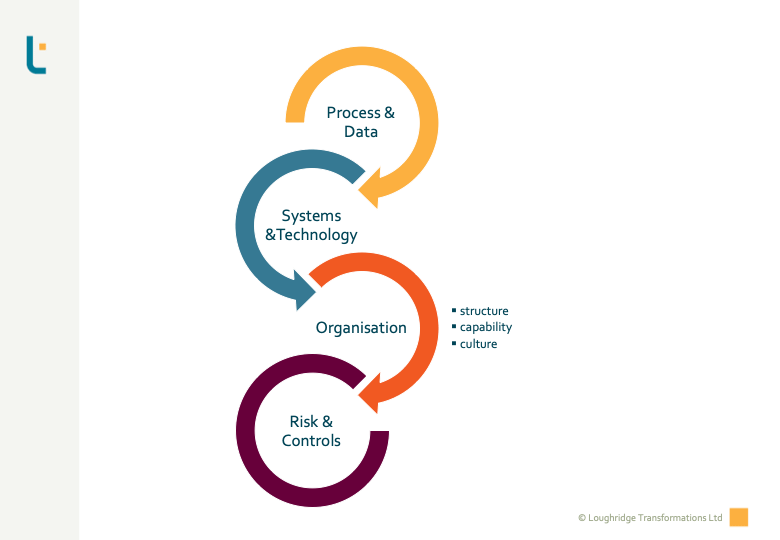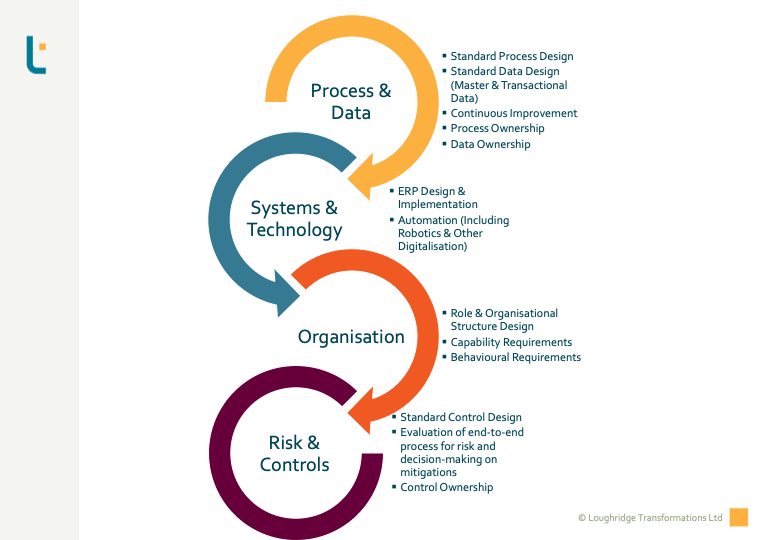Seven Process Must-Do Items – Begin with the Basics

AUTHOR: JENNIFER LOUGHRIDGE
PRINCIPAL CONSULTANT
Jennifer is a Senior Executive Finance professional with 17+ years of global experience. She specialises in Finance Transformation and Continuous Improvement, with particular expertise in Strategy, Performance Management, Business Partnering, Commercial Decision-Making, Corporate Governance and Valuation.
jennifer.loughridge@loughridgetransformations.com
Finance Transformation is a topic, which like many hot topics, lends itself well to buzzwords. Therefore, it is sometimes easy to throw phrases around like:
- agile finance function
- digital solution adoption
- a culture of analytics
- or even one that has been around for a while: business partnering.
More straightforward, at least, than really defining the strategy for the finance function. Certainly less complex than turning those strategies into reality.
Of course, those buzzwords do not come out of thin air. As a result, a forward-looking strategy for Finance Transformation will consider where agility fits within the organisational design. It would not be cutting-edge if it did not incorporate thinking on digital solutions. It must also ensure that transforming data – via analytics into information and insight – is at its core. And, of course, business partnering is almost the raison-d’être of Finance Transformation in the first place.
Process is the Starting Point
However, that is not where we start. Assuming the strategy for the function and the strategic position on cost and differentiation is clear, processes are, in fact, the starting point for transformation.
On the other hand, If you are not thinking about transformation, a process model is still a massive enabler to organisational success – but why is that? It creates value and enhances competitiveness for the organisation.

Our Organisation Wins
You can’t manage what you don’t measure.
Peter Drucker
Further to what Drucker says, if it is not visible, the measurement alone will not take you too far. Performance visibility is important because each person in the chain knows their contribution to delivering the organisation’s outcomes. As for the rest, which organisation does not like improved delivery times, fewer errors, smoother handovers and outcome-orientated work?
Of course, it is easy to say, but it is a process model which delivers all this.
Our People Win
Team members will feel more valued and be less frustrated as time is freed-up for more value-adding and rewarding activities. Moreover, increased engagement and collaboration are critical in these virtual and hybrid working times. The resulting improvements in culture and gains in efficiency, effectiveness and control are compelling.
The Starting Point

When it comes to process models, one size does not fit all. At Loughridge Transformations, we use our Four Elements of Transformation model. The elements of transformation are also the elements of a process model. Moreover, it is fundamentally at the heart of what we do when problem-solving, identifying improvements or working on transformation.
Processes are right there as the first element. Data, of course, goes directly with it.
First, you will want to work out where your organisation is today. – and to help you do that, we have seven must-do questions.

- Is there a transparent process model with well-defined processes defined at the right level?
- Does each process have a clear owner with authority and accountability within the process?
- Are the data definitions and data owners within the process well established?
- Is process performance well understood, and are cycles for improvement in place?
- Are the opportunities within the process for automation exploited?
- Have risk assessments been completed to ensure controls are fit-for-purpose?
- Are the integration points between processes understood and operating effectively?
A framework of seven questions is the ultimate in a keep-it-simple assessment. However, you will want to review your status more thoroughly if you are dealing with something larger-scale. Throughout, it is critical to ask yourself:
- Do I have the right process expertise?
- Do I have the right project and change experience in getting this to work?
After all, we have probably all experienced situations where processes are “in place”, but, in reality, all that exists are some online folders of outdated process flow charts – which no one keeps alive or even references. That is of no use to anyone. But how does that come about? It usually comes down to how it has been implemented.
If those are gaps in your or your organisation’s capabilities, you may want to consider supplementing your in-house team with some experienced consultants such as Loughridge Transformations.
1: A Well-Defined Process Model at the Right Level
There certainly is not a one-size-fits-all answer here. It rather depends on the specifics of the organisation and its goals. Determining what you need and what bureaucracy is can be challenging.

This process architecture could be too much for some organisations and not enough for others. But, in general, it makes sense to consider if the process is:
- transactional or not?
- routine or non-routine?
- required to be scaleable or duplicated and standardised?
For a process that is less transactional and/or non-routine, Level 5 is likely already detailed enough.
Next, consider the scale of your organisation. For example, do you have two or two hundred process operators? The bigger the organisation you have involved, the more critical it is to standardise activities – and that standardisation will usually lead you towards a more detailed design.
2: Process Owner Authorities

All four elements come into play for the process owner – not just the processes! In addition to the technical competencies in the process, data, systems, organisation and controls shown above, a process owner, especially in the early stages of transformation, will also be heavily involved in change management.
They will manage up, down and across – even convincing some stakeholders that end-to-end management is essential. It is often a delicate balance between promoting innovation and preventing needless investment in potentially ineffective technology.
Furthermore, process owners will usually have to convince others that the intention is not to create a “process nirvana”. Some may even see them as an “overhead” and a challenge to other leaders’ authority.
3: Why Data Owners and Definitions are Critical
What makes data important, and why does it sit firmly with processes?
Every step in a process uses data of one kind or another.
And, it probably does not come as news to anyone that data is already a differentiator in organisational success, and this is only increasing – consider the role of data science and data management in remaining competitive.
So, what kind of data do we have in mind?

You can find Unstructured Data in e-mail, white papers, magazine articles, intranet portals, product specifications, or images.
Transactional Data are on events often related to system transactions, such as sales, deliveries, and invoices. They have historical significance or are needed for analysis by other systems. Transactional data are unit-level transactions that use master data entities. However, unlike master data, transactions are inherently temporal and instantaneous by nature.
Metadata are data about other data. It may reside in a formal repository or other forms, such as XML documents, report definitions, column descriptions in a database, log files, connections and configuration files.
Hierarchical Data stores the relationships between other data. It may be stored as part of an accounting system or externally as descriptions of real-world relationships, such as organisational structures or product lines.
Reference Data are a particular type of master data used to categorise other data or relate data to information beyond the boundaries of the enterprise. Both master or transactional data objects can share reference data – for example, countries, currencies, time zones and payment terms.
Master Data are the enterprise’s core data that describes objects around which business is conducted. It typically changes infrequently and can include reference data necessary to operate the organisation. Master data is not transactional, but it does describe transactions.
The Role of the Data Owner
They define it and its creation, its relation to other data, determine how it is configured in any technology and decide whether, for example, the coding is alpha-numeric and sequential or can meaning be assigned to those letters and numbers. For Transactional data, the owner sets parameters and ensures the correct system configuration.
To be clear, the data owner is accountable for managing data. However, there is a lot that comes under that umbrella. They control read/write access, set data standards, and maintain the quality and integrity of the data, for example.
If you do nothing else…
Data is a specialism in its own right, but if you do nothing else, know what types of data exist in your organisation and which process owns which data.
4: Process Performance: Measure, Monitor and Control
How well do you know your processes? And, how effectively can you identify which changes need to be made? You can confidently and positively answer these questions by managing process performance properly. After all, managing the processes well means we can focus on the right things, make informed decisions at all levels in the organisation and continue to improve.
Therefore, to manage process performance effectively, we need to look at three areas:
- Process Measures: determining which measures are aligned with your organisational strategy
- You must understand which inputs and Key Performance Indicators (KPIs) impact critical business outcomes.
- Analytics: leveraging the right analytics will help give the right signals when you execute the process or make any updates
- Remember, you can only improve if the signal is accurate and timely.
- Process Maturity:
- The business process framework and capabilities must also mature as the organisation evolves. Having a maturity model and performing a periodic assessment means organisations can identify additional capabilities to aspire to and develop strategies and plans to grow those capabilities.
To illustrate, let’s look at two Process Performance measurement examples from the Offer-to-Cash process.
Firstly, the Right-First-Time indicator in customer master data maintenance and sales order creation. Delivery delays or late payments caused by incorrect invoicing would not be transparent without that indicator.
Secondly, On-Time in Full (OTIF) is an indicator within production and logistics, which can help identify which parts of the production or logistics processes are faulty or where a minor improvement could lead to a significant positive impact.
It should be clear how these indicators will pinpoint issues impacting the process outcomes and why they are valuable.
5: Process Automation Opportunities and Trends

How do you identify the tasks suitable for automation? They need to be:
- consistent
- repetitive
- effective
- error-free
Some of the typical examples where organisations are applying process automation are:
- Accounts Payable/Accounts Receivable
- Sales Order Processing
- Procurement
- HR
- Manufacturing
The opportunities and benefits are multi-fold:

These are no-brainers. Recent surveys indicate that using Robotic Process Automation (RPA) improves the organisational outcomes as follows:
- Compliance (92%)
- Quality/accuracy (90%)
- Productivity (86%)
- Cost reduction (59%)
In terms of customer service, automation means better availability and a higher degree of reliability. That means happy customers.
For example, implementing a chatbot means customers can have 24×7 support. You may be surprised that usually their problems are easily solved. Automation makes it possible to ensure optimum resource utilisation and get the best and most profitable outcome.
So, let’s look at the trends.

- Hyper-automation through Machine Learning opens the door to automating more complex workflows beyond repetitive and rule-based processes.
- No- or low-code platforms mean no or minimal use of IT to automate, which allows a non-developer to implement quickly without specialist technical skills or training.
- RPA focuses on integrating complex workflows
- Collaboration and communication technologies help keep the data in sync and real-time for all stakeholders.
- Smart technology integration facilitates digital transformation in the physical world.
- For example, voice-activated automation improves workflow efficiency. In addition, it is highly effective when connecting different platforms.
Organisations reaching global audiences through online platforms need a workforce that can function around the clock to provide customer support to different time zones. More futuristic BPA solutions, where AI bots and humans can operate together to create an organisation that never sleeps, is on the horizon.
6: Managing Risks

A good process is where we have assessed the inherent risks, built the appropriate controls, and ensured clear accountability and transparency in the whole landscape.
The Loughridge Transformations framework illustrated here suits all sizes and complexities of organisations.
Risk Assessment
Identifying where risks to compliance or meeting the process goals could develop and materialise is critical—the more granular the assessment, the more accurate and valuable the result. Context is typically set around a sub-process, project, customer, vendor, or other elements of the organisation and then combined and aggregated to an enterprise level.
All operational activities in the organisation occur within defined business processes, and there are bound to be operational process risks with any activities. A proper mitigation approach allows you to consistently identify those risks and design appropriate controls without impeding growth or innovation.
Controls as Process Steps
Enterprise Risk Management and Process Ownership need to come together to design controls that adequately mitigate the process risks, as the Process Owner is accountable for evaluating the end-to-end process for risk, as mentioned above.
Accountability and Transparency
Identifying risk and designing a process for mitigating it is one thing. Another is ensuring the mitigation process is executed – the difference between design-effective and operating-effective, in controls terms. In addition, you need transparency throughout the organisation and for departments to communicate and assign the accountability discussed above. Hence, there is a natural alignment between Enterprise Process Modelling and Enterprise Risk Management – as the integrated lens will lend a better appreciation of inter-dependencies that could potentially augment certain risks.
7: Integration at the Enterprise Level
Integration is needed when moving out of your silo of accountability for one or two processes and developing the process model for the whole organisation, in addition to what we have just mentioned on Managing Risks.

Here is a typical enterprise-level process model example. We have made this very simple with the core processes of designing, building and selling “widgets” for illustrative purposes. An actual enterprise model would have your organisation’s core processes at its core!
Beyond the core processes, you need to be clear on the governing and enabling processes that apply to your organisation, leveraging industry-standard processes, such as Offer-to-Cash and Purchase-to-Pay.
Our Seven Must-Do Items in Process
And there you have Loughridge Transformations‘ Seven Must-Do Items to prevent you from overlooking the basics while reaching for those buzzwords.

If you are interested in learning more about Process Models or how we work generally, please arrange a call!
Find Out More About Working with Loughridge Transformations
Get the Latest from Loughridge Transformations
Subscribe to Our Blog
Alternatively, take a look at our most popular blog posts:
Looking for something else? Here’s what we have been blogging about recently:
Agile Analytics Associates Automation Behaviours Building Trust Business-Partnering CFO Remit Change Management Coaching Collaboration Continuous Improvement Control Design Corporate Governance Data Deployment Design Principles Digital ERP ESG Finance Function Finance Transformation Implementation Migration Off-Shoring Organisation Organisation Design Process Process Design Process Governance Process Performance Productivity Programme Management Office Project Management Readiness Risk & Controls Skills sponsorship Standard Organisational Model Strategy Systems Systems Design Technology Transformation Virtual Working


